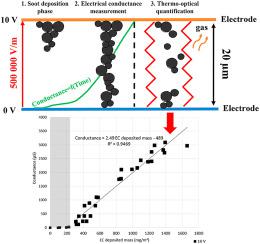Journal of Aerosol Science ( IF 3.9 ) Pub Date : 2021-03-22 , DOI: 10.1016/j.jaerosci.2021.105783 A. Kort , F.-X. Ouf , T. Gelain , J. Malet , R. Lakhmi , P. Breuil , J.-P. Viricelle

|
During a fire in an industrial facility, the main consequences concerning aerosol are the production of large amount of soot and potential resuspension of hazardous material in particulate form. Soot deposition quantification on walls in a room during a fire is essential for the prediction of aerosol quantities that can be transported in the ventilation ducts and clog high efficiency particulate air filters.
For this purpose, accumulative resistive sensors, initially developed for monitoring Diesel Particulate Filters (DPF), have been used to quantify soot particles that are deposited on its sensing side. After validation of the fabrication process via electrical measurements, the sensor response has been studied under different polarization voltages and an experimental protocol for soot quantification has been qualified.
Thanks to those protocols, it was first demonstrated that the polarization voltage has no influence on the deposition velocity. Then, the resistive sensor was calibrated at polarization voltages of 10 V and 0.1 V. For 0.1 V, results are less repeatable and do not allow to propose a correlation between conductance and deposited mass. Better repeatability was found for a polarization voltage of 10 V allowing to propose and develop a calibration procedure aiming to correlate sensor conductance and deposited mass of aerosol.
Indeed, it was proved that the sensor has a blind zone, in terms of conductance, for mass deposit ranging from 0 to 230 mg/m2. A linear calibration curve with a good sensitivity of 2.49 μS mg-1.m2 was obtained for deposited mass between 230 and 1630 mg/m2.
中文翻译:

电阻传感器上烟灰沉积的量化:实验校准方案的建议
在工业设施发生火灾时,与气溶胶有关的主要后果是大量烟灰的产生和潜在的颗粒状危险物质的再悬浮。发生火灾时,房间墙壁上的烟尘沉积量化对于预测可在通风管道中输送的气溶胶数量和阻塞高效微粒空气过滤器至关重要。
为此,最初用于监视柴油机微粒过滤器(DPF)的累积电阻式传感器已用于量化沉积在其传感侧的烟尘颗粒。在通过电测量验证了制造过程之后,已经研究了在不同极化电压下的传感器响应,并且已经确定了用于烟灰定量的实验方案。
由于这些协议,首次证明了极化电压对沉积速度没有影响。然后,在10 V和0.1 V的极化电压下校准电阻传感器。对于0.1 V,结果的可重复性较差,并且不允许提出电导和沉积质量之间的相关性。发现极化电压为10 V时具有更好的可重复性,从而可以提出和开发一种校准程序,旨在使传感器电导与气溶胶沉积质量相关联。
实际上,已证明该传感器在电导率方面具有0至230 mg / m 2范围内的质量沉积物的盲区。用2.49μS良好的灵敏度的线性校准曲线毫克-1的.m 2是230和1630毫克/米之间获得附着量2。











































 京公网安备 11010802027423号
京公网安备 11010802027423号